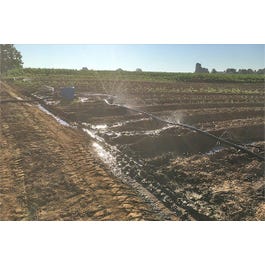
[ad_1]
This may concentrate on irrigation, crop sprays, and frost safety water. When the unique Meals Security Modernization Act (FSMA) regulation was finalized in 2016, floor irrigation water sources required 5 samples per yr and a median of your final 20 samples. After a lot suggestions from the produce trade, the FDA realized that this might not be useful or sensible. In 2017, the FDA determined to rethink the floor water necessities. In 2022, they got here up with a special proposed technique and launched it for public remark. On Could 2, 2024, they finalized the regulation that was proposed in 2022.
You will need to be aware that these modifications apply to pre-harvest ag water that may contact the crop’s edible half. Water utilized by means of drip irrigation underneath plastic to a crop rising above the bottom is just not thought of ag water and isn’t regulated. Rules for water used for post-harvest cooling, washing, gear washing, and hand washing haven’t modified and have already gone into impact.
As an alternative of 5 water samples per yr and a 20-sample water high quality profile, the FDA has moved towards a written water system danger evaluation for every farm, which can think about every farm’s distinctive scenario.
FSMA will ask farmers to carry out a Water High quality Threat Evaluation for his or her pre-harvest water that contacts the edible portion of the crop. This primarily refers to overhead irrigation however also can embrace drip irrigation of floor crops usually eaten uncooked, corresponding to onions, garlic, radishes, turnips, and carrots. It could additionally check with water used for issues like spraying or frost management.
The main dangers from water are a results of its supply, the timing of software, the strategy of software, and the floor traits of the crop. Floor water sources are thought of increased danger than groundwater. Nonetheless, some floor water sources could also be thought of riskier than others. For instance, water from a river will doubtless be at a better danger than water coming straight from a mountain stream or spring. Cisterns, ponds, and different impoundments are additionally thought of floor water. In these circumstances, water assessments might support in assessing the chance of those water sources, however there may be not a longtime variety of assessments which can be required. Wells and municipal water sources are thought of much less dangerous than floor water.
The timing of irrigation is crucial to the chance stage of the water. Micro organism might die off over time from drying, daylight, competitors, and different environmental elements. Irrigation water utilized weeks earlier than harvest shall be much less dangerous than water utilized the day earlier than harvest. Water utilized at planting earlier than the edible a part of the plant is shaped wouldn’t be thought of Ag Water.
The following space of danger to think about could be the applying methodology. The much less doubtless the water will contact the edible portion of the crop, the decrease the chance. Drip irrigation could be much less dangerous than overhead irrigation.
Then, think about the crop being grown. Does the vegetable or fruit have locations the place micro organism can conceal and survive, like the web of a cantaloupe or the middle of a head of lettuce or cabbage? Does it develop near the bottom, like leaf lettuce or strawberries, or does the fruit develop up off of the bottom, like tree fruit and even peppers?
Including these dangers collectively will assist decide in the event you adjust to FSMA and what corrective actions you could have to take. A farmer might have a high-risk water supply like a river, however they may move an FSMA danger evaluation if they’ve a low-risk irrigation methodology or timing or a lower-risk crop like watermelons, which doesn’t have many locations for micro organism to cover.
As this regulation turns into adopted, search for instruments, checklists, or choice bushes that can assist you decide your water high quality danger. Search for Extension Workshops subsequent winter to assist growers develop their Threat Assessments.
The timeline for growers to adjust to this regulation is as follows.
-
- Growers over $500,000 in gross sales should comply by April 7, 2025
-
- Growers over $250,000 in gross sales should comply by April 6, 2026
-
- Growers underneath $250,000 in gross sales should comply by April 5, 2027
For extra info on this regulation, see FSMA Last Rule on Pre-Harvest Agricultural Water or contact Jeff Stoltzfus at Penn State Extension at 717-283-2597.
[ad_2]
Supply hyperlink






